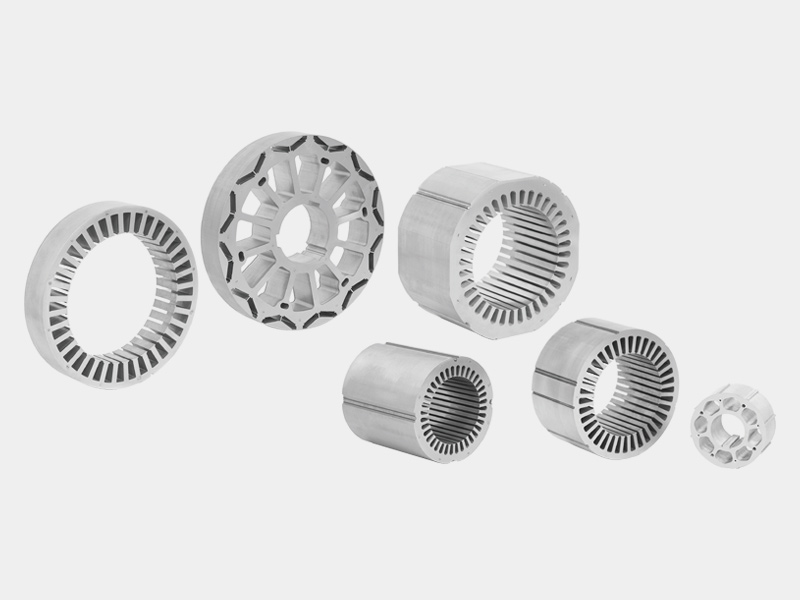Electric motors are integral to countless applications, from household appliances to industrial machinery. The performance of a motor largely depends on the efficiency and durability of its core components, particularly the motor core. Temperature variations significantly impact motor core performance, influencing efficiency, power output, lifespan, and reliability. This article explores the effects of temperature fluctuations on motor cores, including material behavior, magnetic properties, thermal expansion, and insulation degradation.
1. Introduction to Motor Core and Its Role
The motor core, typically made of laminated electrical steel (silicon steel), serves as the magnetic circuit that facilitates energy conversion. When an electric current passes through the windings, the core generates a magnetic field, inducing motion in the rotor. The core’s material properties, geometry, and thermal stability are critical for optimal performance.
Temperature variations—whether from ambient conditions, operational load, or internal losses—can alter these properties, leading to performance degradation. Understanding these effects is essential for designing robust motors for diverse environments.
2. Effects of Temperature on Core Materials
2.1 Magnetic Properties
The magnetic permeability and core losses (hysteresis and eddy current losses) of electrical steel are temperature-dependent.
- Hysteresis Losses: These losses occur due to the lag between magnetization and demagnetization. At higher temperatures, the hysteresis loop area may change, increasing energy loss and reducing efficiency.
- Eddy Current Losses: Eddy currents are induced circulating currents within the core. While resistivity increases with temperature (reducing eddy currents), excessive heat can degrade insulation between laminations, increasing losses.
2.2 Saturation Flux Density
The saturation flux density (Bsat) of core materials decreases as temperature rises. This means the core can store less magnetic energy before saturating, limiting torque and power output. In high-temperature environments, motors may require larger cores or advanced materials to maintain performance.
3. Thermal Expansion and Mechanical Stress
Temperature fluctuations cause thermal expansion in motor cores. Since different materials (e.g., steel, copper windings, insulation) have varying coefficients of thermal expansion (CTE), mismatches can induce mechanical stress.
- Lamination Warping: Repeated heating and cooling cycles can deform thin laminations, increasing air gaps and reducing magnetic efficiency.
- Interference Fits: Components like rotors and shafts may loosen or seize due to differential expansion, leading to misalignment and vibration.

4. Insulation Degradation
The insulation between laminations and windings is critical for preventing short circuits. High temperatures accelerate insulation aging through:
- Thermal Breakdown: Prolonged exposure to heat weakens insulating materials (e.g., varnishes, resins), increasing eddy current losses and the risk of inter-lamination shorts.
- Thermal Cycling: Frequent temperature changes cause expansion/contraction, cracking insulation over time.
5. Efficiency and Power Output
Motor efficiency drops as core losses increase with temperature. Key impacts include:
- Reduced Torque: Higher temperatures lower magnetic flux density, reducing torque production.
- Increased Copper Losses: As the core heats up, winding resistance rises, further decreasing efficiency.
6. Mitigation Strategies
To counteract temperature-related issues, engineers employ several strategies:
- Material Selection: Using high-grade silicon steel with low thermal coefficient losses.
- Cooling Systems: Active (fans, liquid cooling) or passive (heat sinks) methods to dissipate heat.
- Thermal Modeling: Simulations to predict hotspots and optimize core design.
- Improved Insulation: High-temperature-resistant coatings to prolong lifespan.
7. Conclusion
Temperature variations profoundly affect motor core performance by altering magnetic properties, inducing mechanical stress, and degrading insulation. Proper material selection, thermal management, and design optimization are essential to ensure reliability and efficiency across operating conditions. Future advancements in materials science and cooling technologies will further enhance motor resilience in extreme environments.
By understanding these thermal effects, engineers can develop motors that maintain high performance while withstanding temperature fluctuations, ensuring longevity and energy efficiency in diverse applications.

Copyright © Zhejiang Xinzheng Electromechanical Technology Co., Ltd. All Rights Reserved.
This website uses cookies to ensure you get the best experience on our website.
Comment
(0)